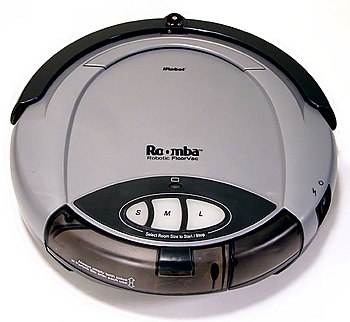Cyberbotics' Robot Curriculum/What are Robots?
Robots are electro-mechanical machines, interacting autonomously with their environment. They include sensors allowing them to perceive the environment. They also include actuators allowing them to modify their environment. Finally, they include a micro-processor allowing them to process the sensory information and control their actuators accordingly.
Robots in our Everyday Life
[edit | edit source]There exist few applications of robots in our everyday life. The most well known applications are probably toys and autonomous vacuum cleaners (see figure with toy robots), but there are also grass mower robots, mobile robots in factories, robots for space exploration, surveillance robots, etc. These devices are becoming increasingly complex in term of sensors, actuators and information processing.
Robots as Artificial Animals
[edit | edit source]Like animals, robots can move, perceive their environment and act. Like animals, they need energy to be able to operate. This is probably why several examples of animal robots were developed for toy applications. This includes the Sony Aibo dog robot (see figure), the Furby toy and later the Pleo dinosaur robot. From the mechanical and electronic points of view, these robots are very advanced. They are equipped with many sensors (distance sensors, cameras, touch sensors, position sensors, temperature sensors, battery level sensors, accelerometers, microphones, wireless communication, etc.) and actuators (motors, speakers, LEDs, etc.). They also include a significant processing power with powerful onboard micro-controllers or micro-processors. Moreover, the latest Aibo robots and several vacuum cleaner robots are able to search their recharging station, to dock on it, recharge their batteries and move on once the battery is charged. This makes them even more autonomous. However, their learning capabilities and ability to adapt to unknown situations is often still very limited. Hence, this affect to comparison with real animals in term of intelligence. When observing an Aibo robot and a real dog, there is no doubt for most observers that the dog is more intelligent than the robot. The same could probably apply if you compare the Pleo toy robot with a real reptile. However, since reptiles appear to be more primitive than dogs, the difference of intelligence in the Pleo / reptile case may not be as evident as in the Aibo / dog case.
The conclusion we can draw from the above paragraph is that the hardware technology for intelligent robots is currently available. However, we still need to invent a better software technology to drive these robots. In other words, we currently have the bodies of our intelligent robots, but we lack their minds. This is probably the reason why most of the toy and vacuum cleaner robots described here are still provided with a remote control...
Hence this book will not focus on robot hardware, but rather on robot software because robot software is the greatest research challenge to overcome to be able to design more and more intelligent robots.

